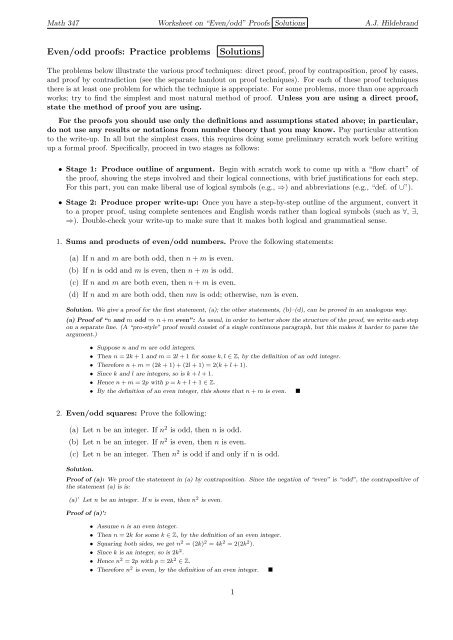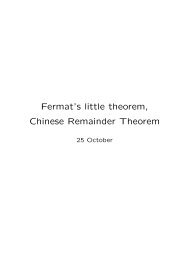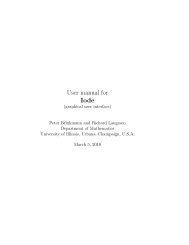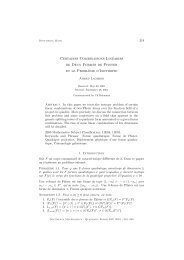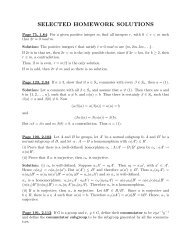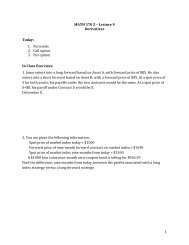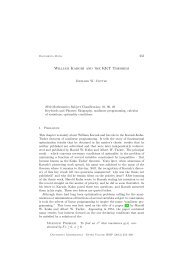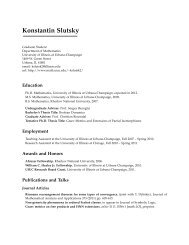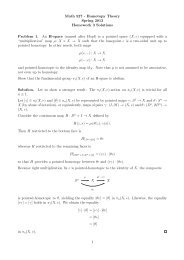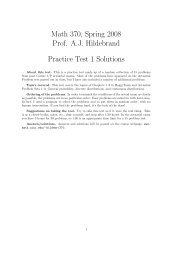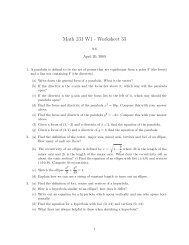Even/odd proofs: Practice problems Solutions
Even/odd proofs: Practice problems Solutions
Even/odd proofs: Practice problems Solutions
You also want an ePaper? Increase the reach of your titles
YUMPU automatically turns print PDFs into web optimized ePapers that Google loves.
Math 347 Worksheet on “<strong>Even</strong>/<strong>odd</strong>” Proofs <strong>Solutions</strong> A.J. Hildebrand<br />
<strong>Even</strong>/<strong>odd</strong> <strong>proofs</strong>: <strong>Practice</strong> <strong>problems</strong> <strong>Solutions</strong><br />
The <strong>problems</strong> below illustrate the various proof techniques: direct proof, proof by contraposition, proof by cases,<br />
and proof by contradiction (see the separate handout on proof techniques). For each of these proof techniques<br />
there is at least one problem for which the technique is appropriate. For some <strong>problems</strong>, more than one approach<br />
works; try to find the simplest and most natural method of proof. Unless you are using a direct proof,<br />
state the method of proof you are using.<br />
For the <strong>proofs</strong> you should use only the definitions and assumptions stated above; in particular,<br />
do not use any results or notations from number theory that you may know. Pay particular attention<br />
to the write-up. In all but the simplest cases, this requires doing some preliminary scratch work before writing<br />
up a formal proof. Specifically, proceed in two stages as follows:<br />
• Stage 1: Produce outline of argument. Begin with scratch work to come up with a “flow chart” of<br />
the proof, showing the steps involved and their logical connections, with brief justifications for each step.<br />
For this part, you can make liberal use of logical symbols (e.g., ⇒) and abbreviations (e.g., “def. of ∪”).<br />
• Stage 2: Produce proper write-up: Once you have a step-by-step outline of the argument, convert it<br />
to a proper proof, using complete sentences and English words rather than logical symbols (such as ∀, ∃,<br />
⇒). Double-check your write-up to make sure that it makes both logical and grammatical sense.<br />
1. Sums and products of even/<strong>odd</strong> numbers. Prove the following statements:<br />
(a) If n and m are both <strong>odd</strong>, then n + m is even.<br />
(b) If n is <strong>odd</strong> and m is even, then n + m is <strong>odd</strong>.<br />
(c) If n and m are both even, then n + m is even.<br />
(d) If n and m are both <strong>odd</strong>, then nm is <strong>odd</strong>; otherwise, nm is even.<br />
Solution. We give a proof for the first statement, (a); the other statements, (b)–(d), can be proved in an analogous way.<br />
(a) Proof of “n and m <strong>odd</strong> ⇒ n + m even”: As usual, in order to better show the structure of the proof, we write each step<br />
on a separate line. (A “pro-style” proof would consist of a single continuous paragraph, but this makes it harder to parse the<br />
argument.)<br />
• Suppose n and m are <strong>odd</strong> integers.<br />
• Then n = 2k + 1 and m = 2l + 1 for some k, l ∈ Z, by the definition of an <strong>odd</strong> integer.<br />
• Therefore n + m = (2k + 1) + (2l + 1) = 2(k + l + 1).<br />
• Since k and l are integers, so is k + l + 1.<br />
• Hence n + m = 2p with p = k + l + 1 ∈ Z.<br />
• By the definition of an even integer, this shows that n + m is even. �<br />
2. <strong>Even</strong>/<strong>odd</strong> squares: Prove the following:<br />
(a) Let n be an integer. If n 2 is <strong>odd</strong>, then n is <strong>odd</strong>.<br />
(b) Let n be an integer. If n 2 is even, then n is even.<br />
(c) Let n be an integer. Then n 2 is <strong>odd</strong> if and only if n is <strong>odd</strong>.<br />
Solution.<br />
Proof of (a): We proof the statement in (a) by contraposition. Since the negation of “even” is “<strong>odd</strong>”, the contrapositive of<br />
the statement (a) is is:<br />
(a)’ Let n be an integer. If n is even, then n 2 is even.<br />
Proof of (a)’:<br />
• Assume n is an even integer.<br />
• Then n = 2k for some k ∈ Z, by the definition of an even integer.<br />
• Squaring both sides, we get n 2 = (2k) 2 = 4k 2 = 2(2k 2 ).<br />
• Since k is an integer, so is 2k 2 .<br />
• Hence n 2 = 2p with p = 2k 2 ∈ Z.<br />
• Therefore n 2 is even, by the definition of an even integer. �<br />
1
Math 347 Worksheet on “<strong>Even</strong>/<strong>odd</strong>” Proofs <strong>Solutions</strong> A.J. Hildebrand<br />
(b) can be proved in the same way as (a).<br />
Proof of (c): Here we have an “if and only if” statement, which breaks into the following two implications:<br />
(i) Let n ∈ Z. If n 2 is <strong>odd</strong>, then n is <strong>odd</strong>.<br />
(ii) Let n ∈ Z. If n is <strong>odd</strong>, then n 2 is <strong>odd</strong>.<br />
Now, (i) is the same as (a), while (ii) is the contraposition of (b), and hence equivalent to (b). Thus, (c) is a consequence of<br />
(a) and (b).<br />
3. Cool application I: Sums of <strong>odd</strong> perfect squares. Can a sum of two perfect squares be another<br />
perfect square? Sure; for example, 3 2 + 4 2 = 5 2 , 5 2 + 12 2 = 13 2 , 6 2 + 8 2 = 10 2 , 7 2 + 24 2 = 25 2 . However,<br />
no matter how much you try, you won’t find any examples in which the two perfect squares on the left are<br />
both <strong>odd</strong>. Your task is to prove this, i.e.:<br />
Prove that a sum of two <strong>odd</strong> perfect squares is never a perfect square.<br />
(An interesting consequence of this result is that in any right triangle in which all sides have integer length<br />
at least one of the two shorter sides must be of even length.)<br />
Proof: The argument given below makes use of the results of Problems 1 and 2. Without using these results, the proof would<br />
become a bit longer. One would need to consider separately the cases when n, m, p below have a specified parity (even or<br />
<strong>odd</strong>), and show that in each of these cases a contradiction arises.<br />
We first restate the result to be proved in a more explicitly form:<br />
(∗) If s and t are <strong>odd</strong> perfect squares, then s + t is not a perfect square.<br />
Proof of (∗): We use the method of contradiction.<br />
• Suppose s and t are <strong>odd</strong> perfect squares, and assume that s + t is also a perfect square.<br />
• Then s = n 2 , t = m 2 , and s + t = p 2 , for some n, m, p ∈ Z, by the definition of a perfect square.<br />
• Since, by assumption, s = n 2 and t = m 2 are <strong>odd</strong>, the integers n and m must be <strong>odd</strong> as well (by Problem 2).<br />
• Hence n = 2k + 1 and m = 2l + 1 for some k, l ∈ Z, by the definition of an <strong>odd</strong> integer.<br />
• Since the sum of two <strong>odd</strong> numbers is even (by Problem 1), s + t = p 2 is even.<br />
• Hence p, must be even as well (again by Problem 2).<br />
• Therefore p = 2h for some h ∈ Z.<br />
• Thus we have<br />
s = n 2 = (2k + 1) 2 , t = m 2 = (2l + 1) 2 , s + t = p 2 = (2h) 2 .<br />
• Equating the two expressions for s + t and simplifying, we get<br />
(2k + 1) 2 + (2l + 1) 2 = (2h) 2 ,<br />
4k 2 + 4k + 1 + 4l 2 + 4l + 1 = 4h 2 ,<br />
4(k 2 + k + l 2 + l) + 2 = 4h 2 ,<br />
k 2 + k + l 2 + l − h 2 = − 1<br />
2 .<br />
• In the latter equation the left side is an integer, while the right-hand side is not an integer.<br />
• Thus we have arrived at a contradiction.<br />
• Therefore our assumption that s + t is a perfect square is false, and we have shown that if s and t are <strong>odd</strong><br />
perfect squares, then s + t cannot be not a perfect square. �<br />
4. Cool application, II: Quadratic equations with no integer/rational solutions:<br />
(a) Prove the following:<br />
If a, b, c are <strong>odd</strong> integers, then the equation ax 2 + bx + c = 0 has no integer solution.<br />
[This is the equation considered at the beginning of Chapter 2 of the text and it is a nice illustration<br />
of the power of “parity arguments”. Don’t look up the solution in the text; try to find it<br />
on your own. 1 For the proof, you may use any of the properties of sums and products of even/<strong>odd</strong><br />
integers established in Problem 1.]<br />
(b) Prove that the above result remains true if “integer solution” is replaced by “rational solution”.<br />
Solution. In the <strong>proofs</strong> below we will make repeated use of the properties of sums and products of <strong>odd</strong>/even numbers<br />
established in Problem 1 (e.g., that a sum of an even and an <strong>odd</strong> number is <strong>odd</strong>, etc.).<br />
1 Hint: Consider the parity (even or <strong>odd</strong>) of ax 2 + bx + c.<br />
2
Math 347 Worksheet on “<strong>Even</strong>/<strong>odd</strong>” Proofs <strong>Solutions</strong> A.J. Hildebrand<br />
Proof of (a): We use the method of contradiction. Suppose a, b, c are <strong>odd</strong> integers and x is an integer solution to<br />
ax 2 + bx + c = 0. We distinguish between two cases, x even and x <strong>odd</strong>; in each case, we will show that ax 2 + bx + c<br />
must be <strong>odd</strong> and hence cannot equal 0 (which is even since it is of the form 2 · k with k = 0), thus establishing a<br />
contradiction.<br />
If x is even, then ax 2 and bx are both even since the product of an even integer with any integer is even. Since<br />
the sum of two even numbers is even, ax 2 + bx is even as well. However, since, by assumption, c is <strong>odd</strong> and the<br />
sum of an <strong>odd</strong> and an even number is <strong>odd</strong>, ax 2 + bx + c must be <strong>odd</strong>.<br />
If x is <strong>odd</strong>, then ax 2 and bx are both <strong>odd</strong> since, by assumption, a and b are <strong>odd</strong> and the product of <strong>odd</strong> integers<br />
is <strong>odd</strong>. Since the sum of two <strong>odd</strong> numbers is even, ax 2 + bx is even. Since, by assumption, c is <strong>odd</strong> and the sum<br />
of an <strong>odd</strong> and an even number is <strong>odd</strong>, we again conclude that ax 2 + bx + c must be <strong>odd</strong>.<br />
Thus, in either case, we obtain that ax 2 + bx + c is <strong>odd</strong> and hence cannot be equal to 0. Therefore, our assumption<br />
that there is an integer solution to the equation ax 2 + bx + c = 0 is false. Hence, this equation has no integer<br />
solutions. �<br />
Proof of (b): Again we use the method of contradiction. Suppose a, b, c are <strong>odd</strong> integers and x is a rational<br />
solution to ax 2 + bx + c = 0. Since x is rational number, it can be written as x = p/q for some integers p and q.<br />
We may assume the fraction p/q is in reduced form, i.e., the numerator and denominator have no common factors.<br />
Substituting x = p/q into the equation ax 2 + bx + c = 0 and clearing denominators, we get<br />
a(p/q) 2 + b(p/q) + c = 0,<br />
ap 2 + bpq + cq 2 = 0.<br />
We now argue in a much the same way as in the case of (a), considering the possible parities of p and q and<br />
showing that in each case, ap 2 + bqp + cq 2 must be <strong>odd</strong>, and hence cannot equal 0.<br />
Since we assumed p/q to be a reduced fraction, p and q cannot both be even, so we are left with three cases: (i)<br />
p even and q <strong>odd</strong>; (ii) p <strong>odd</strong> and q even; (iii) p <strong>odd</strong> and q <strong>odd</strong>.<br />
In case (i), ap 2 is even, bpq is even, and cq 2 is <strong>odd</strong>, so ap 2 + bqp + cq 2 is <strong>odd</strong>.<br />
In case (ii), ap 2 is <strong>odd</strong>, bpq is even, and cq 2 is even, so ap 2 + bqp + cq 2 is <strong>odd</strong>.<br />
In case (iii), all three terms ap 2 , bpq, and cq 2 , are <strong>odd</strong>, so ap 2 + bqp + cq 2 is <strong>odd</strong> as well.<br />
Thus, in either case, we obtain that ap 2 + bqp + cq 2 is <strong>odd</strong> and hence cannot be equal to 0. Therefore, our<br />
assumption that there is a rational solution to the equation ax 2 + bx + c = 0 is false. Hence, this equation has no<br />
rational solutions. �<br />
5. Cool application, III: Irrationality <strong>proofs</strong>: Prove that √ 2 is irrational.<br />
Proof: We argue by contradiction and suppose that the conclusion is false, i.e., that √ 2 is not irrational. Then<br />
√ 2 is rational, i.e., of the form √ 2 = p/q for some integers p and q (where q �= 0). We may assume that the<br />
fraction p/q is in reduced form, i.e., that p and q have no common factors. In particular, we know that<br />
(∗) at least one of p and q must be <strong>odd</strong>.<br />
Squaring each side of √ 2 = p/q and clearing denominators, we get<br />
� �2 p<br />
2 = =<br />
q<br />
p2<br />
,<br />
q2 (1)<br />
2q 2 = p 2 .<br />
Since q 2 is an integer, 2q 2 is even, so by (1), p 2 = 2q 2 must be even as well, and by Problem 2 it follows that p<br />
itself be even. Hence p = 2k for some integer k.<br />
Substituting this into (1) and simplifying, we get<br />
(2)<br />
2q 2 =(2k) 2 = 4k 2 ,<br />
q 2 = 2k 2 .<br />
But (2) shows that q 2 is twice an integer and therefore even, and by Problem 2 it follows that q itself must be<br />
even.<br />
Altogether we have obtained that both p and q are even, contradicting (∗). This contradiction shows that our<br />
original assumption, that √ 2 is not irrational, was false. Hence we have proved that √ 2 is irrational. �.<br />
3


